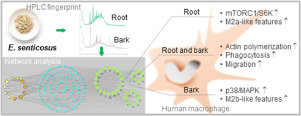当前位置:
X-MOL 学术
›
Phytomedicine
›
论文详情
Our official English website, www.x-mol.net, welcomes your feedback! (Note: you will need to create a separate account there.)
A comparative study on root and bark extracts of Eleutherococcus senticosus and their effects on human macrophages.
Phytomedicine ( IF 7.9 ) Pub Date : 2020-02-06 , DOI: 10.1016/j.phymed.2020.153181 Lu Jin 1 , Michael Schmiech 1 , Menna El Gaafary 2 , Xinlei Zhang 3 , Tatiana Syrovets 1 , Thomas Simmet 1
Phytomedicine ( IF 7.9 ) Pub Date : 2020-02-06 , DOI: 10.1016/j.phymed.2020.153181 Lu Jin 1 , Michael Schmiech 1 , Menna El Gaafary 2 , Xinlei Zhang 3 , Tatiana Syrovets 1 , Thomas Simmet 1
Affiliation

|
BACKGROUND
Eleutherococcus senticosus or Siberian ginseng is a medicinal plant containing adaptogenic substances believed to regulate immune responses. Both, the root and stem bark are commonly used in traditional medicines.
PURPOSE
The purpose of the present study is to chemically characterize E. senticosus root and bark extracts and to compare their effects on functions of human primary macrophages.
STUDY DESIGN AND METHODS
HPLC-DAD-MS analysis was used to characterize chemical constituents of alcoholic extracts from E. senticosus root and bark. The data obtained and available databases were combined for network pharmacology analysis. Involvement of predicted pathways was further functionally confirmed by using monocyte-derived human macrophages and endotoxin-free E. senticosus root and bark extracts.
RESULTS
Chemical analysis showed that the root extract contained more syringin, caffeic acid, and isofraxidin than the bark extract. At variance, bark extract contained more sesamin and oleanolic acid. Coniferyl aldehyde and afzelin were below the limit of quantification in both extracts. Network pharmacology analysis indicated that constituents of E. senticosus might affect the immune cell phenotype and signaling pathways involved in cell metabolism and cytoskeleton regulation. Indeed, both extracts promoted actin polymerization, migration, and phagocytosis of E. coli by macrophages pointing to macrophage polarization towards the M2 phenotype. In addition, treatment with E. senticosus root and bark extracts decreased phosphorylation of Akt on Ser473 and significantly reduced expression of the hemoglobin scavenger receptor CD163 by macrophages. Neither extract affected expression of CD11b, CD80, or CD64 by macrophages. In addition, macrophages treated with the bark extract, but not with the root extract, exhibited activated p38 MAPK and NF-κB and released increased, but still moderate, amounts of proinflammatory TNF-α and IL-6, anti-inflammatory IL-10, and chemotactic CCL1, which all together point to a M2b-like macrophage polarization. Differently, the root extract increased the IL-4-induced expression of anti-inflammatory CD200R. These changes in monocytes are in agreement with an increased M2a macrophage polarization.
CONCLUSION
The ability of E. senticosus root and bark extracts to promote polarization of human macrophages towards anti-inflammatory M2a and M2b phenotypes, respectively, might underlay the immunoregulatory activities and point to potential wound healing promoting effects of this medicinal plant.
中文翻译:

刺肠肠球菌根和树皮提取物及其对人巨噬细胞影响的比较研究。
背景技术刺肠肠球菌或西伯利亚人参是含有被认为调节免疫反应的适应原性物质的药用植物。根皮和茎皮都常用于传统药物中。目的本研究的目的是化学表征番荔枝根和树皮提取物,并比较它们对人类原代巨噬细胞功能的影响。研究设计和方法HPLC-DAD-MS分析用于表征从E. senticosus根和树皮中提取的酒精成分。将获得的数据和可用的数据库合并以进行网络药理分析。通过使用单核细胞衍生的人巨噬细胞和无内毒素的大肠杆菌(E. senticosus)根和树皮提取物进一步证实了预测途径的参与。结果化学分析表明,根提取物比树皮提取物含有更多的丁香精,咖啡酸和异氟西丁。不同的是,树皮提取物含有更多的芝麻素和齐墩果酸。两种提取物中的松柏树皮醛和afzelin均低于定量限。网络药理学分析表明,刺五加成分可能影响免疫细胞表型和参与细胞代谢和细胞骨架调节的信号通路。实际上,两种提取物均通过巨噬细胞(指向M2表型的巨噬细胞极化)来促进大肠杆菌的肌动蛋白聚合,迁移和吞噬作用。此外,用E. senticosus根和树皮提取物处理可降低Ser473上Akt的磷酸化,并显着降低巨噬细胞对血红蛋白清除剂受体CD163的表达。两种提取物均不影响巨噬细胞CD11b,CD80或CD64的表达。此外,用树皮提取物而不是根提取物处理的巨噬细胞表现出活化的p38 MAPK和NF-κB并释放增加但仍然适量的促炎性TNF-α和IL-6,抗炎性IL-10和趋化性CCL1,它们共同指向类似M2b的巨噬细胞极化。不同的是,根提取物增加了IL-4诱导的抗炎CD200R表达。单核细胞中的这些变化与增加的M2a巨噬细胞极化一致。结论刺五加根和树皮提取物分别促进人类巨噬细胞向抗炎M2a和M2b表型极化的能力,
更新日期:2020-02-07
中文翻译:

刺肠肠球菌根和树皮提取物及其对人巨噬细胞影响的比较研究。
背景技术刺肠肠球菌或西伯利亚人参是含有被认为调节免疫反应的适应原性物质的药用植物。根皮和茎皮都常用于传统药物中。目的本研究的目的是化学表征番荔枝根和树皮提取物,并比较它们对人类原代巨噬细胞功能的影响。研究设计和方法HPLC-DAD-MS分析用于表征从E. senticosus根和树皮中提取的酒精成分。将获得的数据和可用的数据库合并以进行网络药理分析。通过使用单核细胞衍生的人巨噬细胞和无内毒素的大肠杆菌(E. senticosus)根和树皮提取物进一步证实了预测途径的参与。结果化学分析表明,根提取物比树皮提取物含有更多的丁香精,咖啡酸和异氟西丁。不同的是,树皮提取物含有更多的芝麻素和齐墩果酸。两种提取物中的松柏树皮醛和afzelin均低于定量限。网络药理学分析表明,刺五加成分可能影响免疫细胞表型和参与细胞代谢和细胞骨架调节的信号通路。实际上,两种提取物均通过巨噬细胞(指向M2表型的巨噬细胞极化)来促进大肠杆菌的肌动蛋白聚合,迁移和吞噬作用。此外,用E. senticosus根和树皮提取物处理可降低Ser473上Akt的磷酸化,并显着降低巨噬细胞对血红蛋白清除剂受体CD163的表达。两种提取物均不影响巨噬细胞CD11b,CD80或CD64的表达。此外,用树皮提取物而不是根提取物处理的巨噬细胞表现出活化的p38 MAPK和NF-κB并释放增加但仍然适量的促炎性TNF-α和IL-6,抗炎性IL-10和趋化性CCL1,它们共同指向类似M2b的巨噬细胞极化。不同的是,根提取物增加了IL-4诱导的抗炎CD200R表达。单核细胞中的这些变化与增加的M2a巨噬细胞极化一致。结论刺五加根和树皮提取物分别促进人类巨噬细胞向抗炎M2a和M2b表型极化的能力,


























 京公网安备 11010802027423号
京公网安备 11010802027423号